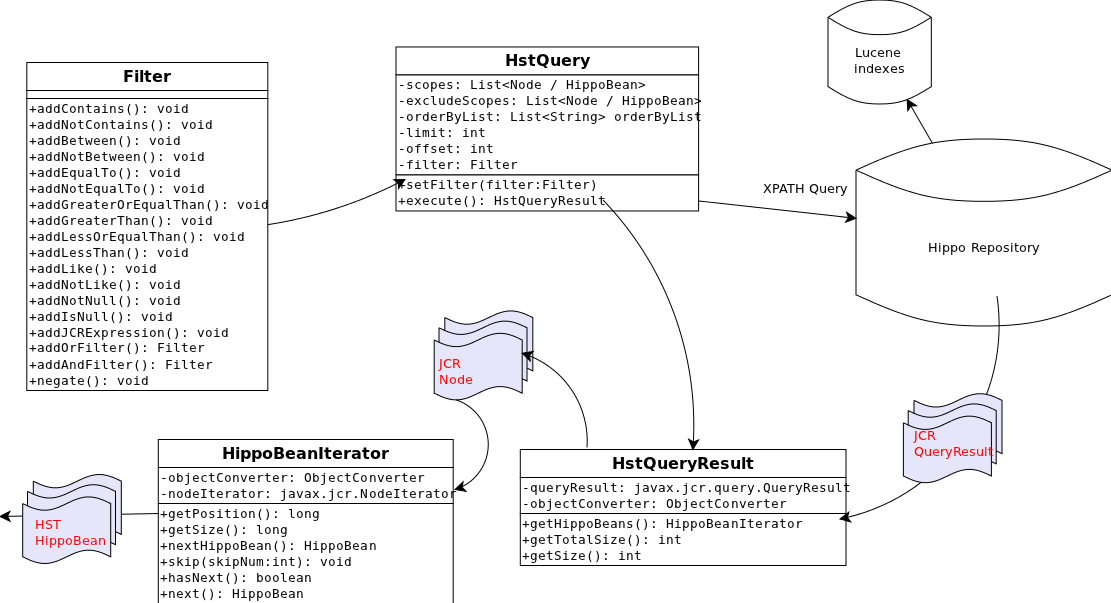Delivery Tier Legacy Search API
As of Bloomreach Experience Manager 11.1, we recommend using the Fluent Search API which is more intuitive to use and results in better code readability. However, future releases of Bloomreach Experience Manager will continue to support the Legacy Search API.
Introduction
Goal
Create and execute search queries using the Legacy Search API in Hippo's delivery tier.
Background
Hippo's delivery tier (HST) provides a Java API to create and execute searches. When an HST query is executed, the HstQuery object is translated into a JCR XPath query, which is executed in the Hippo Repository. The Hippo Repository returns JCR Nodes as hits, that in turn are mapped to HippoBeans in the HstQueryResult object.
Examples
Below is an example of a Java HstComponent and a schematic (not exact!) drawing of how all involved components interact.
More detailed documentation about using the Legacy Search API can be found on the following pages:
MySearchComponent Java Code Snippet
Java Class MySearchComponent:
public class MySearchComponent extends BaseHstComponent {
@Override
public void doBeforeRender(final HstRequest request,
final HstResponse response)
throws HstComponentException {
HstRequestContext context = request.getRequestContext();
SearchInfo info = getComponentParametersInfo(request);
// the scope to search below, for example /content/documents/example
HippoBean scope = context.getSiteContentBaseBean();
try {
// create the query to search below 'scope', return beans that are
// of type BaseDocument bean or a subclass/sub-jcr-types, the
// third argument, 'true', indicates whether to include subtypes
HstQuery hstQuery =
context.getQueryManager().createQuery(scope,
BaseDocument.class, true);
// always set a limit! The limit is normally the pageSize,
// for example 10
hstQuery.setLimit(pageSize);
// the offset : Assume requested page is 3. Then the offset is 20
hstQuery.setOffset(pageSize * (currentPage - 1));
// we assume ordering on property "mynamespace:date" descending
hstQuery.addOrderByDescending("mynamespace:date");
// parse a free text query to remove invalid chars. The argument
// 'false' means no wildcards allowed
String parsedQuery = SearchInputParsingUtils.parse(query, false);
if (StringUtils.isNotEmpty(parsedQuery)) {
// create a filter
Filter f = hstQuery.createFilter();
// add a constraint: Only Documents that contain the terms
// in parsedQuery will be a hit
// Note that "." means: Search in the entire Document
// including all descendant jcr nodes
f.addContains(".", parsedQuery);
// apply the filter
hstQuery.setFilter(f);
}
// execute the query
HstQueryResult result = hstQuery.execute();
// set the result, info and parsedQuery on the HstRequest : It is
// then available in the JSP
request.setAttribute("result", result);
request.setAttribute("info", info);
request.setAttribute("query", parsedQuery);
} catch (QueryException e) {
throw new HstComponentException(
"Exception occured during creation or execution of HstQuery.", e);
}
}
}
See Render a Search Query Result for example JSP and Freemarker templates for the above example.
Overview of Involved Components


